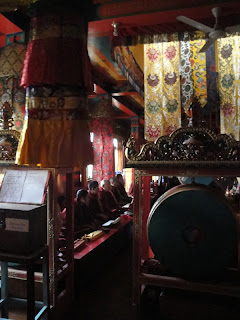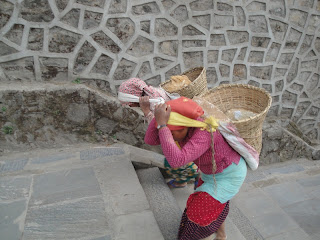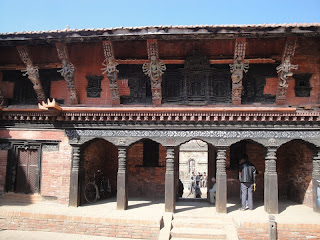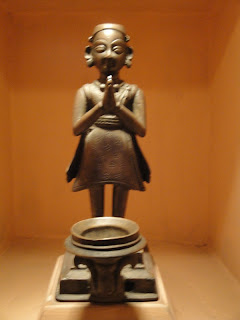We have said good-bye to the 18 of our group who are going home. James, I and 4 other ladies are being brought to the airport first to fly to Nepal. We are there in plenty of time. Praveen checks us all in as a group, which is a mistake this time. We are told that we have too much luggage and they charge us a lot this time. We can't see why but we collect contributions from each person and James goes as told to what seems to be the other end of the airport and pays. We have to go through more lines (security etc) and we see money being given under hand. The flight by Indian Airlines is good and soon we are in Kathmandu, Nepal .Kathmandu is the capital and the largest metropolitan city of Nepal. It is also the gateway to Nepal tourism.
After landing, the first line we have to stand in is the one to buy our visa. Everything takes a little time but finally we are done with everything and have our luggage too. Rasheem, our Odysseys Unlimited tour guide for this part, is awaiting us.
The history of the city of Kathmandu, which is inseparable from that of the Kathmandu valley, dates back to ancient times. Archaeological explorations indicate that Kathamandu and the two other sister towns in the valley were the oldest towns and are traced to the period between 167 BC and 1 AD.
We check into our Hotel Crowne Plaza-Soaltee.
We are doing our first sightseeing that afternoon. We visit the "Monkey" Temple Swayambhunath, an ancient (ca. 250 A.D.) and sacred Buddhist complex second only to Boudhanath (which we visit in a couple of days too).
At the entrance Rasheem bought some special coins which ...
... we tried to toss into the little pot in front of the statue for good luck. Rasheem is successful, the rest of us is not.
Then we walked up the hill to the temple.
The temple is considered an architectural treasure and features a white dome that symbolizes Nirvana, a 13-tiered golden spire, and the all-seeing "eyes" of the Buddha on all four sides.
There were lots of hawker stalls but they were just closing up since "business hours" here seemed to be over just when we arrived.
He is making candles to sell to those who want to make an offering ...
... like this family.
Look what you see peeking out of the house on the very left.
These children were just so cute and just like other children all over the world.
Although the site is considered Buddhist, the place is revered by both Buddhists and Hindus.
This stupa was hit by lightning a couple of weeks before our vivit and heavy reconstruction was going on ... with bamboo scaffolding.

The monks were chanting. Something comforting about it.

Rules of conduct hang outside the door. Too bad that that is necessary.


I really liked this poster.
Prayer wheels.
A good view of the town.
Pilgrims like to descend the 365 steps leading to the stupa.
Top of the steps.
There were not too many monkeys. This one found a piece of coconut.
Any of my friends wanting to complain about their housework?
A family picnic.
The view from our hotel room window. The servers got a lecture. It was quite interesting.
Gorkha, authentic Himalayan Brew since May 2006
 The next morning we enjoy a walking tour of Kathmandu City. There are three Durbar Squares (city square with palaces, temples, shrines, important buildings and monuments etc) in the Kathmandu Valley and of course they are all UNESCO sites.
The next morning we enjoy a walking tour of Kathmandu City. There are three Durbar Squares (city square with palaces, temples, shrines, important buildings and monuments etc) in the Kathmandu Valley and of course they are all UNESCO sites. We start with Patan Durbar Square.
All the carvings in Nepal seem to be teak wood and incredibly well preserved.
Teakwood leaves made into plates and bowls. We saw these quite often for sale.
Decorations on the palace. Statues with more then two arms are gods. So more arms, so more powerful.
A lot of renovation going on everywhere.



Garuda

The Golden Gate
One of several wells where the people (mainly women) get their water.
Later we see a old drawing of this particular well in the museum.
The strip you see in this picture is a fixture on most temples. It allows the blessings to come down from heaven.
Entering a Hindu temple.
Look up in the door way. A mandala on the ceiling.
A boy is being washed and massaged with oil.
This is a most interesting shop.
He actually makes the water bubble with vibrations in seconds by just rubbing the rim of the bowl.
Vicki had a pain he said he could heal. Can't remember whether he did.
No comment needed.
 I didn't take notes (shame on me) and am not sure which museum this was.
I didn't take notes (shame on me) and am not sure which museum this was.I think it was The Patan Museum
inside PatanDurbar Square which specializes in bronze statues and religious objects, which include nearly 900 items. Anyway, this was very interesting. |
These things are so old. I marvel at the expressions of the statues. I think this is an oil lamp.


Ganesha's transport, the Rat. Ganesha is the god statue with the elephant head. He always has his feet on a rat.

The throne.



 Vajrasattva and Prajna
Vajrasattva and Prajna1859
Vajrasattva, the "Sixth Buddha" is depicted in mystic union with his consort, traditionally they may be seen only by the initiated. Their lion throne is an ancient symbol of majesty. Both carry thunderbolts (vajra), the means to enlightenment, and bells, symbolizing impermanence because the sounds do not last. (copied from the little museum sign)
You know I am a bit of a prude. The Kama Sutra carvings from the temples in Varanasi had to be censored. But this little statue just seems to have a special expression. I think it is very sweet. I do like it very much.
This is the drawing of the well in the picture earlier.
Ah, yes, another try of local beer.
After lunch we walked around Kathmandu Durbar Square.
Spices. The smell of Asia.
Roasted corn on the cob anybody?
My mother had a sewing machine like this.
I am on vacation and have no time to look at these fabrics? Not fair.
Nepal seems similar to India but yet so different. You walk around in these streets somehow with a different feeling.
Each street or city section seems to be specializing in some other wares.
This is a Gurkha soldier. Thinking of my wonderful father-in-law.
Hanuman, the monkey god,
is worshiped as a symbol of physical strength, perseverance and devotion.

Kumari's House
The house of the Living Goddess, the Kumari Bahal looks like the monastery that was constructed in 1757 by Jaya Prakash Malla. Inside it lives the young girl who is selected to be the town's living goddess, until she reaches her first puberty and reverts to being a normal mortal.

Rasheem holding up a photo of the present Kumari (poor girl!).

A picture of a Pharmacy for Sarah.
How do you get to the front door?
Another well. Getting water is very important for everybody.

Dinner was always arranged by Rasheem on hotel premises, just a little walk. He thought we would be tired of Indian food so it was Italian one night and Chinese another.
















































































































1 comment:
Just remarkable.
Post a Comment